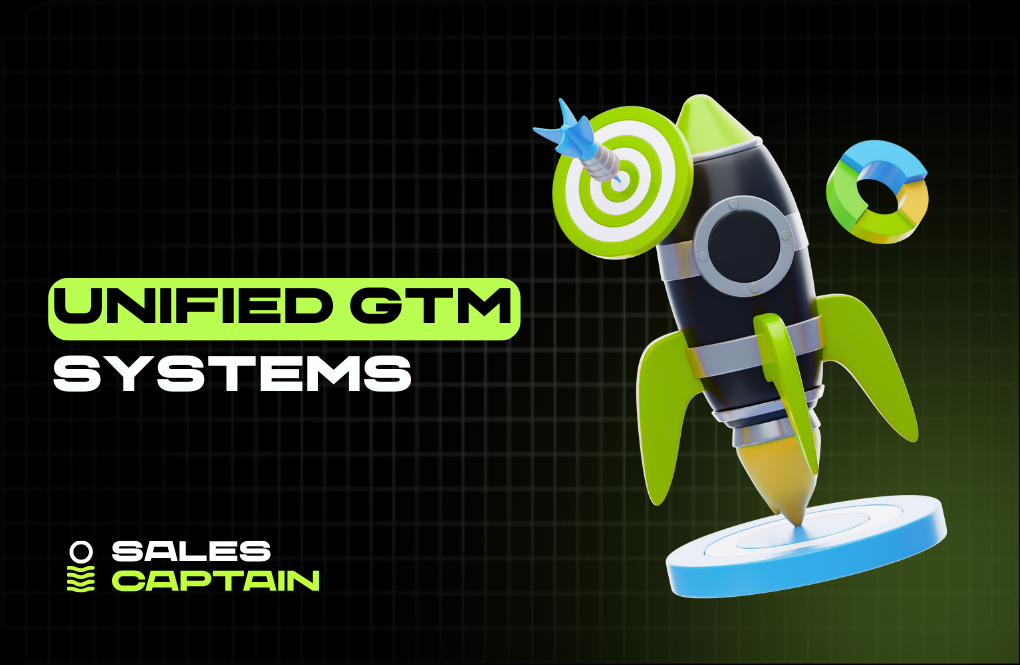

Automated Sales Intelligence in 2025: Definition, Key Features, and Benefits

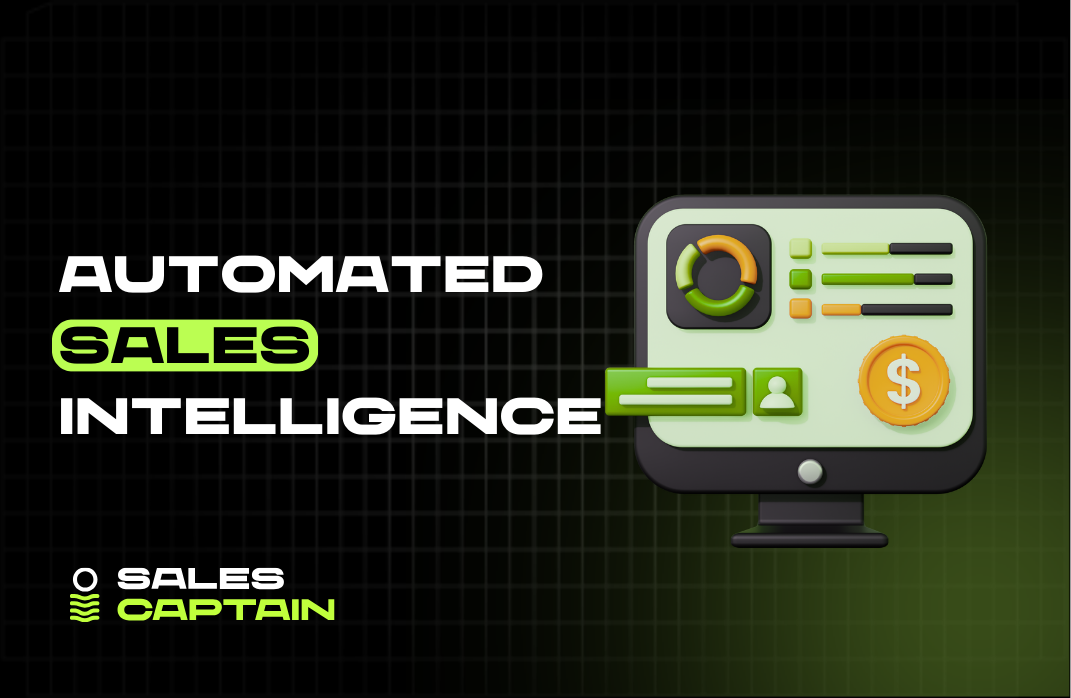
Automated sales intelligence is the process of collecting, analyzing, and applying sales data using AI and software-driven systems to help go-to-market teams prospect, qualify, and engage leads without manual effort. Unlike static spreadsheets, these systems surface the most relevant insights, from verified contact details to real-time buyer intent, directly inside your CRM and sales tools. In practice, this means up-to-date lead profiles, intent signals, AI-driven outreach suggestions, and a pipeline that grows without requiring constant manual effort.
What is Automated Sales Intelligence?
Definition and key concepts
Automated sales intelligence is the process of collecting, analyzing, and applying sales data using AI and software-driven systems to help go-to-market teams prospect, qualify, and engage leads, without manual effort. It’s not just data gathering. It’s intelligent data use across the sales funnel.
Instead of reps scrambling for research or relying on outdated spreadsheets, software automatically surfaces the most relevant insights, from contact details to buyer intent signals, right inside your tools. It’s speed, precision, and relevance on autopilot.
In practice, this means constantly-updated lead profiles, real-time buying signals, AI-driven suggestions for outreach, and pipelines that grow consistently without requiring sales reps to do all the heavy lifting.
How it differs from traditional sales intelligence
Traditional sales intelligence is static. Contact lists get outdated. Insights require hours of manual research. Sales and marketing waste time working with stale or incomplete data.
Automated sales intelligence flips that. AI evaluates data at scale and in real time. Instead of buying a fixed list and hoping it still works, your systems listen for changes, like leadership moves, tech adoption, or keyword surges, and update your targeting automatically.
It also integrates tightly into your GTM system. Instead of being a separate tool your team has to reference, the intelligence fuels outreach, triggers workflows, scores leads, and sends alerts, all without human intervention.
Evolution of sales intelligence with AI and automation
Sales intelligence used to be mostly about access. Whoever had the best Rolodex won. Then came online databases and APIs. But even then, the problem was scale. You had the data, but not the means to act on it fast enough.
AI changed that. It reads signals across millions of data points, web behavior, company updates, technographic shifts, and pushes next steps to your team in real time. Automation made it scalable. AI made it smart.
Now, GTM is increasingly technical. You don’t hire an SDR to research leads from scratch. You build a system that finds signals, scores accounts, picks the right prospects, and launches tailored messaging without anyone lifting a finger. That’s a fundamental shift.
The role of data in automated sales processes
Data is the system’s fuel, and it's only useful if it's fresh, relevant, and actionable. The new GTM motion isn’t about checking boxes. It’s about using data to trigger the right workflow at the right moment.
Sales intelligence platforms pull from intent providers, website traffic, firmographic APIs, CRM events, and interaction history. Then AI determines what matters: Did the VP of Marketing just view your pricing page? Is this company expanding headcount in sales? Have they adopted a new tech that your tool integrates with?
All of these data points power automated plays. They get scored, filtered, and routed through workflows that either engage the lead, enrich the profile, notify someone, or skip if it’s not worth it. It’s not “more data.” It’s the right data used correctly.
How Automated Sales Intelligence Works
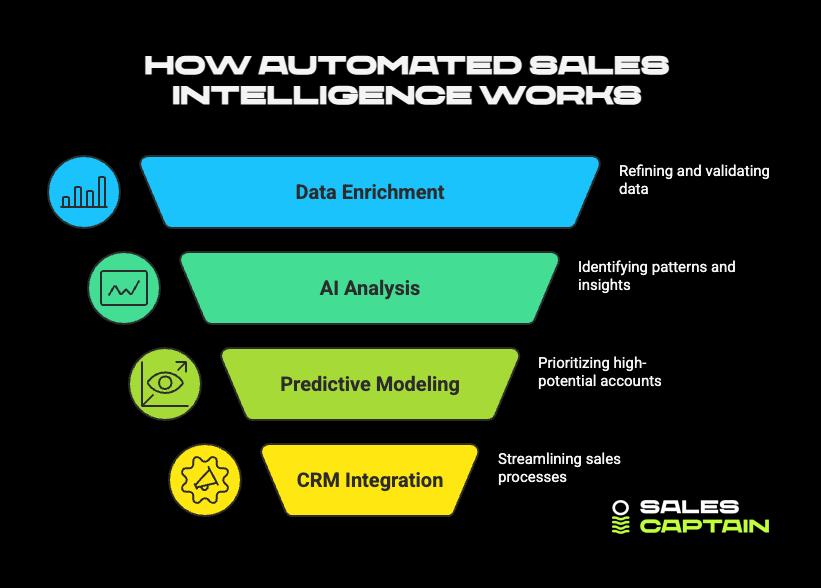
Data collection sources: internal, external, real-time
There are three core data sources that automated sales intelligence tools rely on:
- Internal: CRM records, previous interactions, deal histories
- External: firmographics, technographics, employee changes, funding rounds
- Real-time: intent data, site visits, LinkedIn activity, product usage
Automated tools continuously monitor, compare, and sync these data streams. When a key signal appears, like a decision-maker accepting a LinkedIn connection or a company raising Series A, your platform captures the event and triggers the next action, whether that’s enrichment, scoring, or outbound.
AI and machine learning in data enrichment and analysis
AI handles the mess before you even see it. It deduplicates data, fills in missing fields, validates contact info, and even infers job roles or purchasing readiness from behavior and firmographic inputs. That’s enrichment, making your data usable.
Machine learning adds the "intelligence” layer. It looks for patterns across all your accounts and deals to suggest which factors actually lead to a close. Over time, the models refine themselves, improving scoring, routing, and timing automatically.
The result: Sales outreach isn't just fast. It's relevant, contextual, and hard to ignore.
Real-time analytics and predictive modeling
What’s happening right now? Who’s showing intent? Which companies show signals of expansion? These are no longer manual questions. Automated sales intelligence tools track down-to-the-minute activities and serve up predictive scores and suggested actions.
Predictive modeling then prioritizes accounts most likely to convert, not just based on historical closes, but on dozens of real-time variables. Who opened an email, which page they lingered on, or whether the company is actively hiring in relevant departments.
Combine this with automation, and reps only see accounts worth their focus. Everything else is deprioritized or handled by AI workflows.
Integration with CRM and sales engagement platforms
Data is only useful if it flows into your systems. That’s why automated sales intelligence tools integrate tightly with CRMs like HubSpot or Salesforce, and sales engagement platforms like Outreach or Apollo.
New contacts get automatically synced. Accounts with high scores are routed to the right rep. Behavior triggers fire off sequenced emails. Notes get logged. Tasks get created. The sales rep never has to touch half of it.
Automation connects signals with action. No copy-pasting between platforms. No breaking workflows. Just a GTM system that runs end-to-end.
Key Features of Automated Sales Intelligence Tools
Contact and company data enrichment
Keeping contacts enriched is the foundation. If you're working with missing emails or blank job titles, nothing else matters.
Email addresses, phone numbers, locations
Enrichment platforms tap into APIs, proprietary databases, and scraping techniques to fill in key identifiers: verified emails, direct dials, HQ locations. These get synced to your CRM and updated as needed.
Firmographics and technographics
AI matches companies against firmographic benchmarks, industry, headcount, revenue, geography, and technographic layers. Are they using Salesforce? Did they just start using HubSpot? These details drive better segmentation and prioritization.
Intent and trigger data
Behavioral insights
Platforms monitor on-site activity, email engagement, social signals, and ad interactions to infer interest. Who clicked the pricing page? Who forwarded the whitepaper? That data drives smarter follow-ups.
Technographic change signals
If a company just integrated a complementary tool, or dropped a competitor, that's a prime trigger. Tools pick up on these shifts, flag them, and suggest tailored messaging.
Buyer intent indicators
Third-party intent providers like Bombora detect surging interest in relevant topics. Combine that with engagement patterns and internal CRM data, and you can pinpoint accounts that are warming up without even talking to them yet.
Lead scoring and prioritization
Instead of treating every lead equally, AI scores them. Based on firmographics, activity, signals, and deal history, each contact gets a score, so your reps start with the leads most likely to convert.
Scoring isn’t static either. It updates in real time as new data comes in, which means your pipeline isn’t just full, it’s pointed in the right direction.
AI-powered outreach recommendations
Some platforms go a step further. They don’t just tell you who to contact, they tell you what to say. Based on industry, past response patterns, and signal context, they suggest subject lines, pain points to address, and channels to use.
This reduces time spent on crafting messages and can drastically improve reply rates, especially at scale.
Campaign optimization and performance analytics
When campaigns run, automated systems track engagement down to the click. Which sequences convert? What messaging resonates? AI analyzes the results and suggests optimizations.
Operators can then adjust segment targeting, messaging tone, or outreach timing with real data instead of gut feeling.
Data cleansing and deduplication
Outreach fails when your data is cluttered. Bounce rates spike, SDRs waste time, and your CRM becomes a graveyard.
Automated tools clean this up constantly. They merge duplicates, remove invalid records, and maintain formatting standards across your entire pipeline.
Integration and automation workflows
Sales intelligence isn’t useful if it sits in another tab. Integrations bring it into your existing GTM stack. More importantly, automation workflows act on the data. A new intent signal? Kick off a sequence. Data changed? Enrich and rescore.
GTM is now a system. Tools like Clay or high-output agencies like SalesCaptain build these into efficient, repeatable infrastructure.
Real-time alerts and notifications
Speed matters. Getting notified when a decision-maker visits your site or a key contact gets promoted can be the difference between being first or being forgotten.
These triggers fire alerts in Slack, email, or CRM. Reps get context fast. Relevance goes up. So does reply rate.
Benefits of Using Automated Sales Intelligence
Faster prospecting with better-qualified leads
Instead of manually researching or guessing who to reach out to, reps are handed high-intent, enriched leads on a silver platter. Automated workflows surface prospects who are not only in your ICP, but who are also showing signals of readiness.
No more endless scrolling on LinkedIn. Just a focused list based on real activity, not assumptions.
Improved personalization at scale
Personalization used to mean reps spent 10 to 15 minutes per lead. With data-rich profiles, trigger events, and AI writing assistants, personalized outreach can now happen in seconds, and still feel authentic.
Signals drive relevance. That’s what makes automated intel powerful in outbound: it makes personalization scalable.
Shortened sales cycles
Timing is everything. Automated systems engage leads when they're most active, most interested, and most likely to convert. That alone can shave days or weeks off your sales cycle.
Plus, better data means fewer follow-ups, less back-and-forth, and quicker decisions.
Increased rep productivity and efficiency
Reps spend less time researching, cleaning lists, or chasing dead leads. Instead, they spend time selling. That shift alone increases productivity across the board.
Repetitive tasks get handled by automation. Reps handle the human parts, building relationships, closing deals.
Enhanced sales forecasting accuracy
When your data is fresher, your scoring is tighter, and your pipeline is cleaner, you'll forecast better. Period.
Demand patterns become more visible. Buying readiness is clearer. Win rates improve. Leadership stops guessing.
Alignment between sales and marketing teams
Automated sales intelligence creates a shared source of truth. Marketing sends MQLs that are actually workable. Sales provides feedback loops based on real outcomes. Everyone sees the same data.
This alignment compounds over time. Better messaging, better handoffs, and a stronger GTM engine.
Top Automated Sales Intelligence Tools in 2025
ZoomInfo
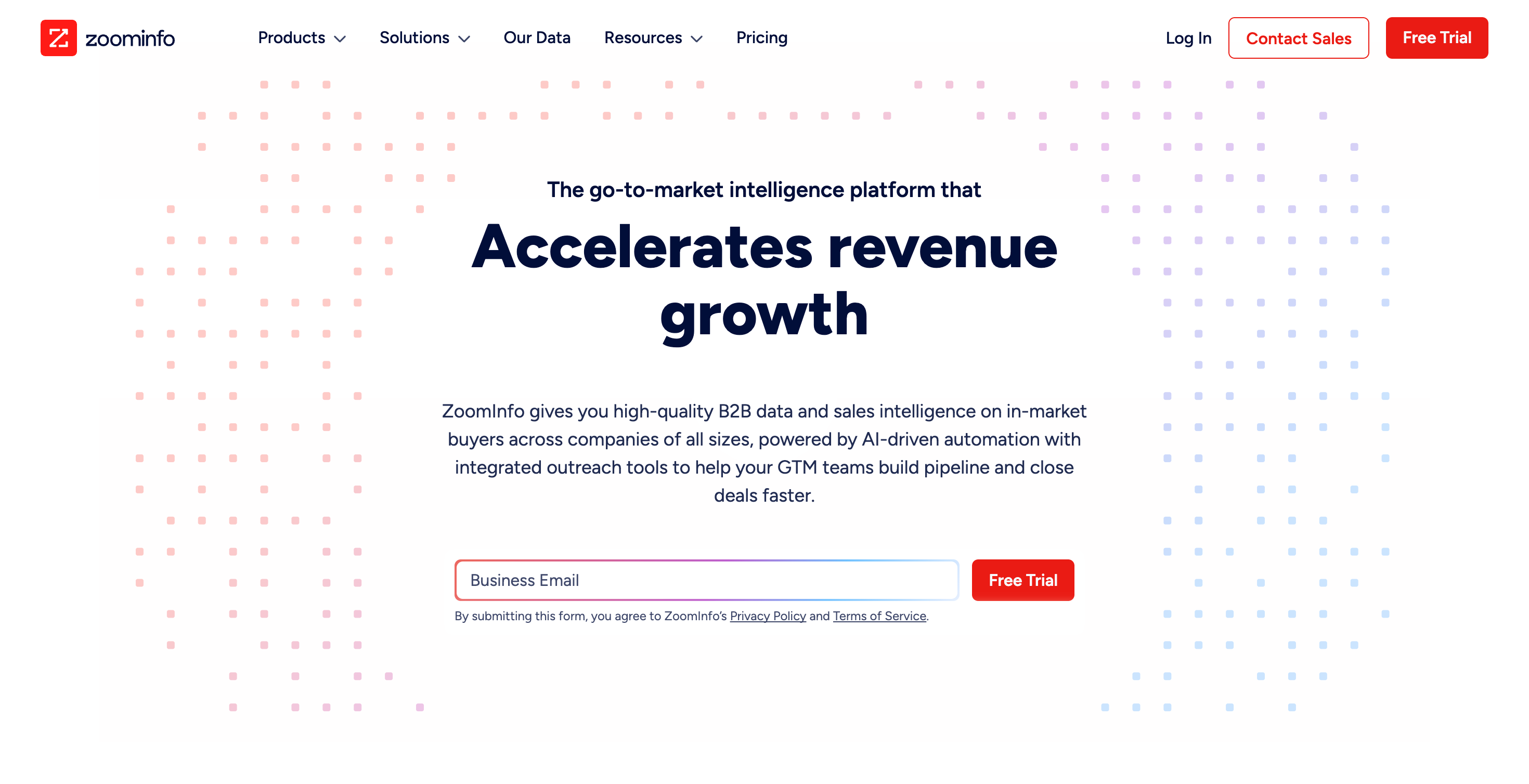
Still one of the most robust contact databases on the market. Known for depth and accuracy of data. Strong integrations with major CRMs. Best used for large enterprise teams that need volume.
LinkedIn Sales Navigator

Great for prospecting and relationship-driven outreach. Advanced filters, job change alerts, and real-time engagement tracking. Less automation, more context.
Apollo.io
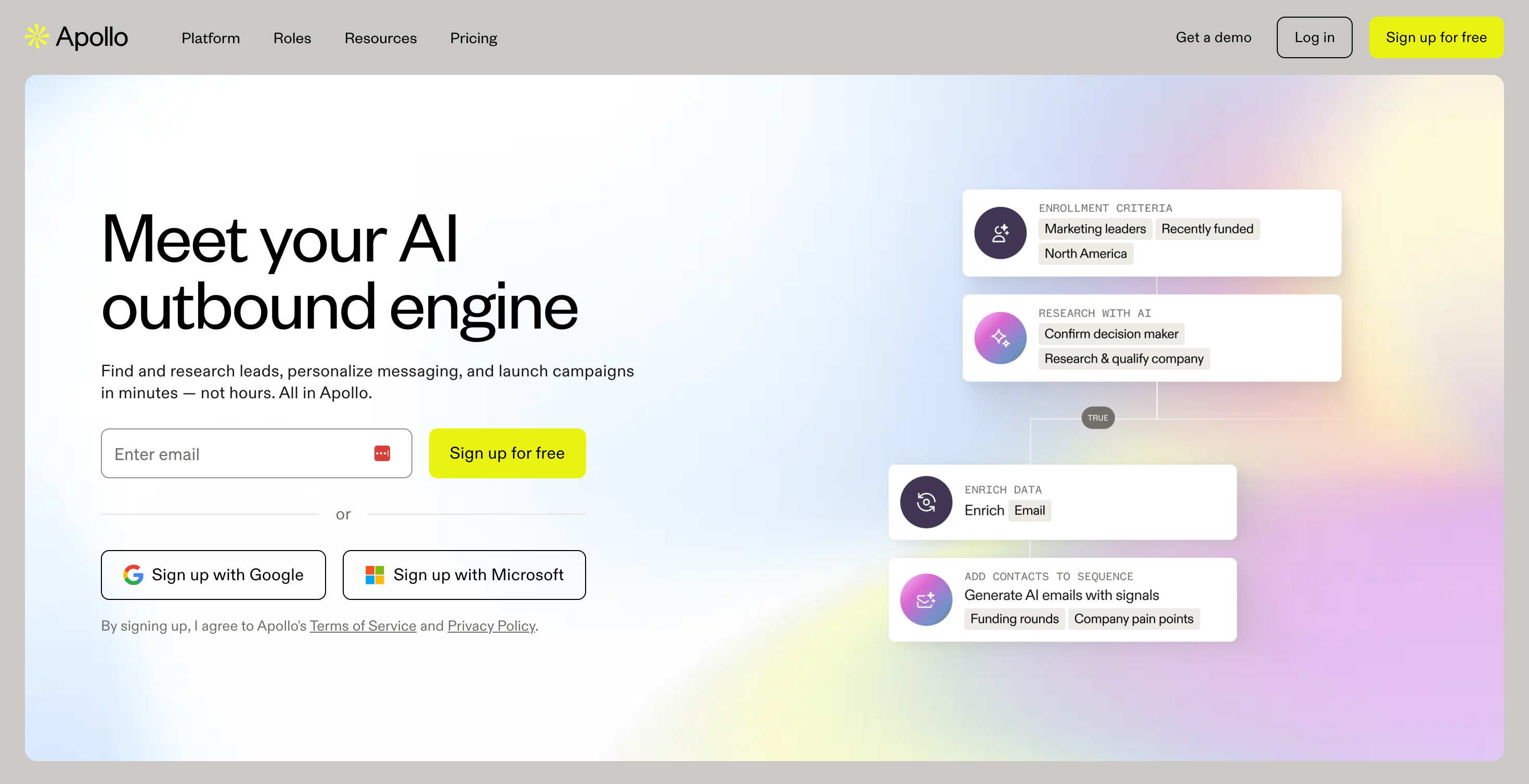
A powerful sales engagement suite combined with prospecting data. Strong for startups and operators who want to build and run outbound campaigns in one place.
Cognism
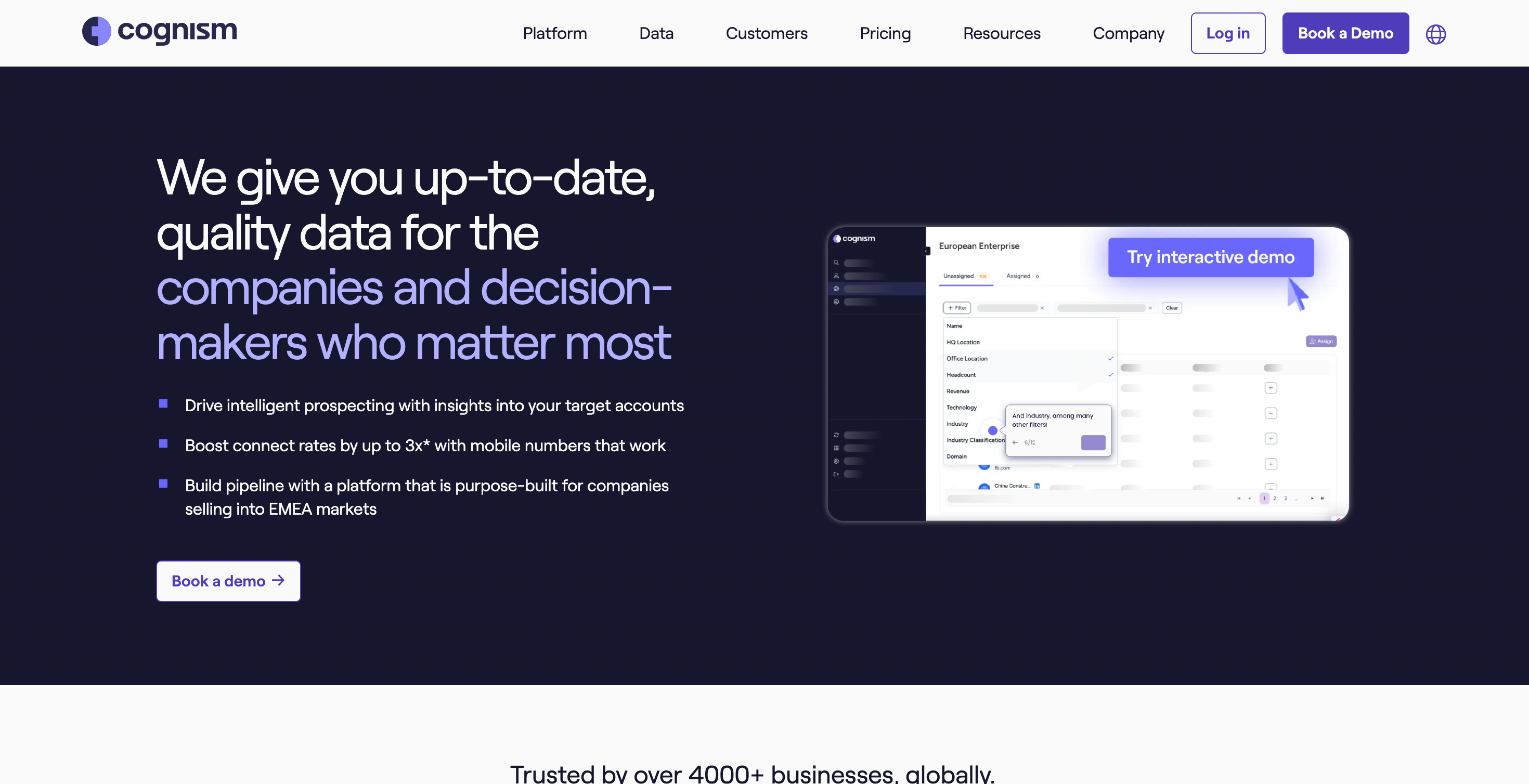
Aggressive European data compliance and a strengths in EMEA coverage. Focuses on accuracy and verified contact data at scale.
Dealfront (Leadfeeder)
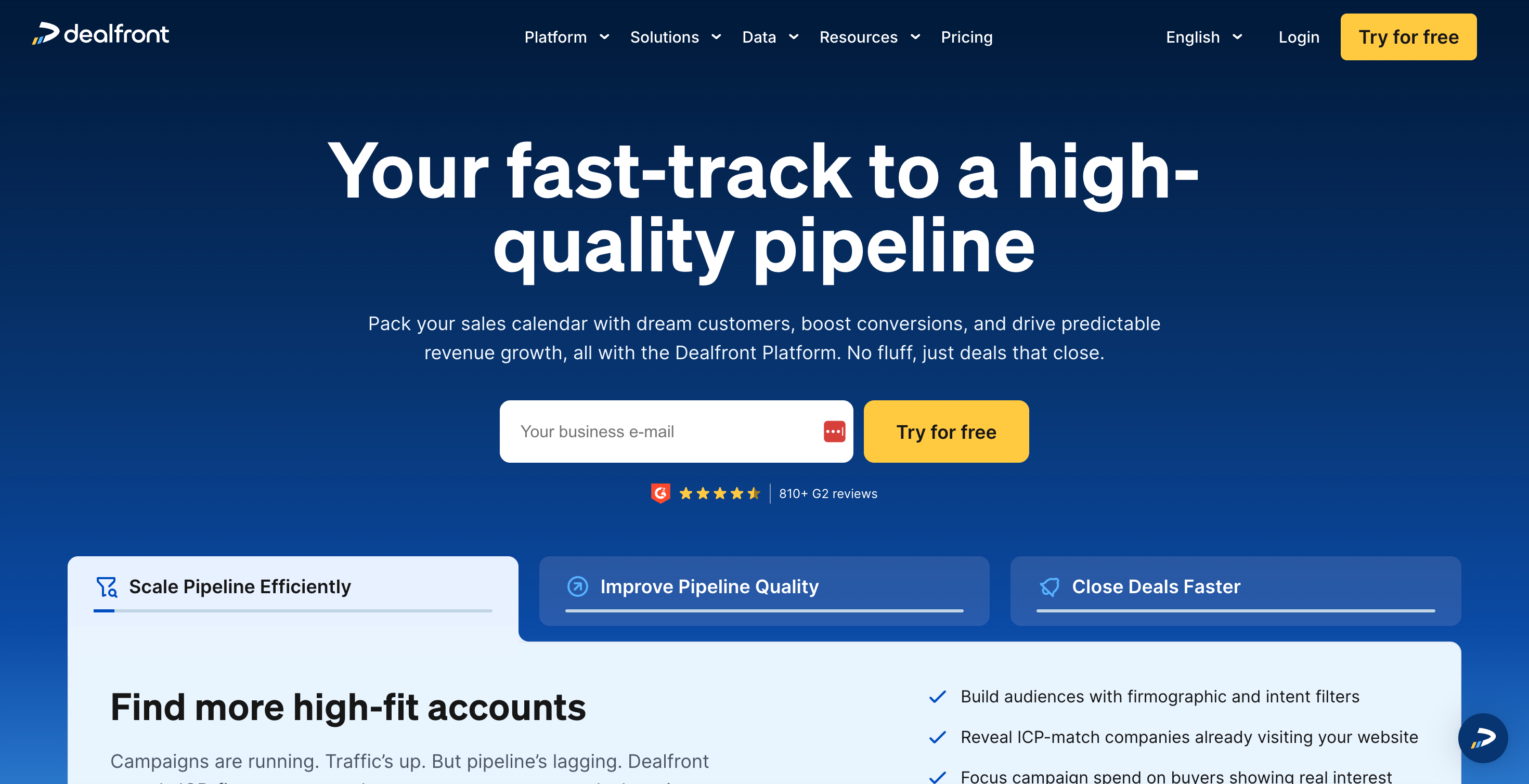
Tracks website visits and turns anonymous traffic into named companies. Great for intent-driven marketing and creating highly-specific retargeting or outreach plays.
Instantly
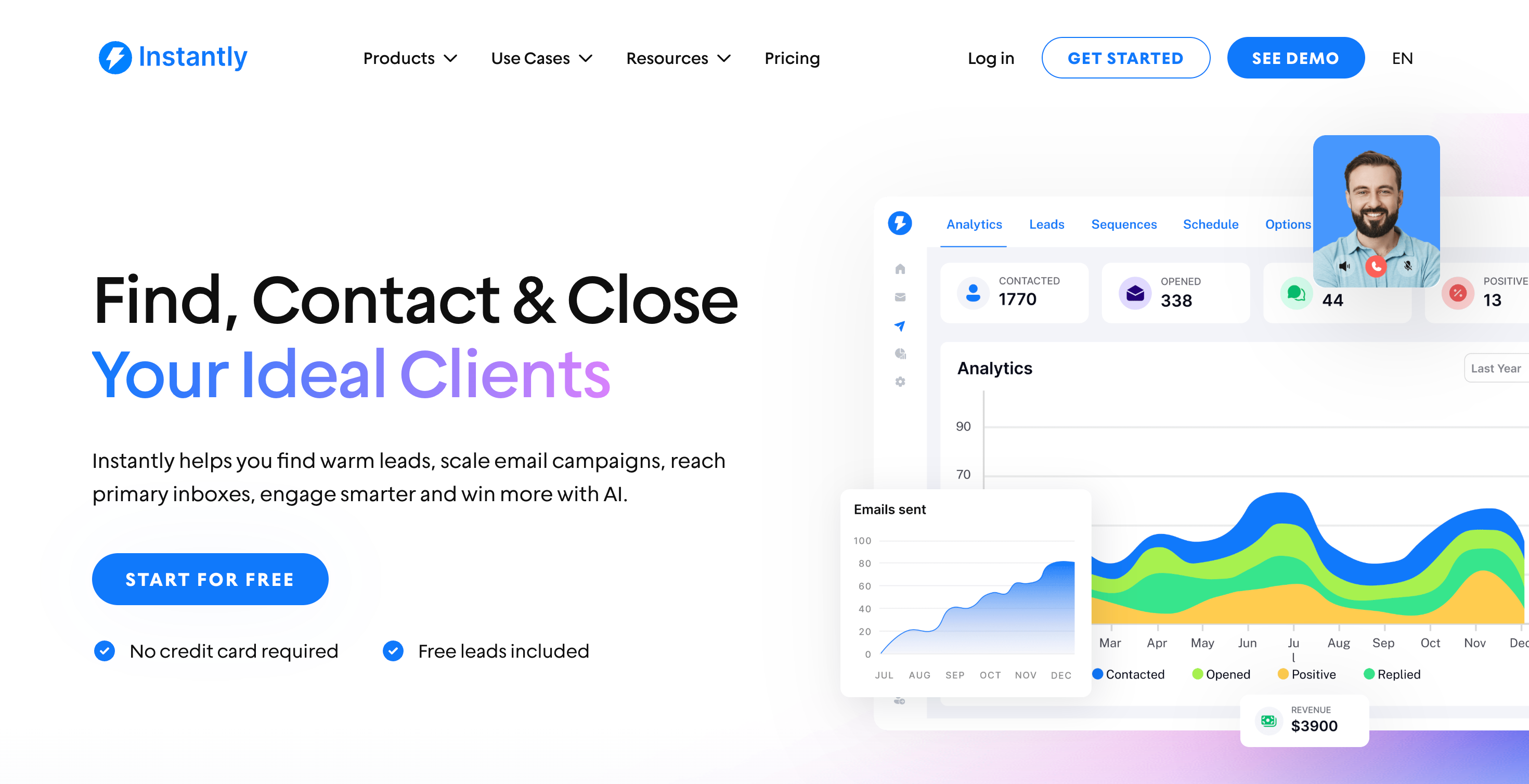
Popular with cold email operators for high volume outreach. Simplified UX, inbox rotation, and basic targeting baked in.
Seamless.AI
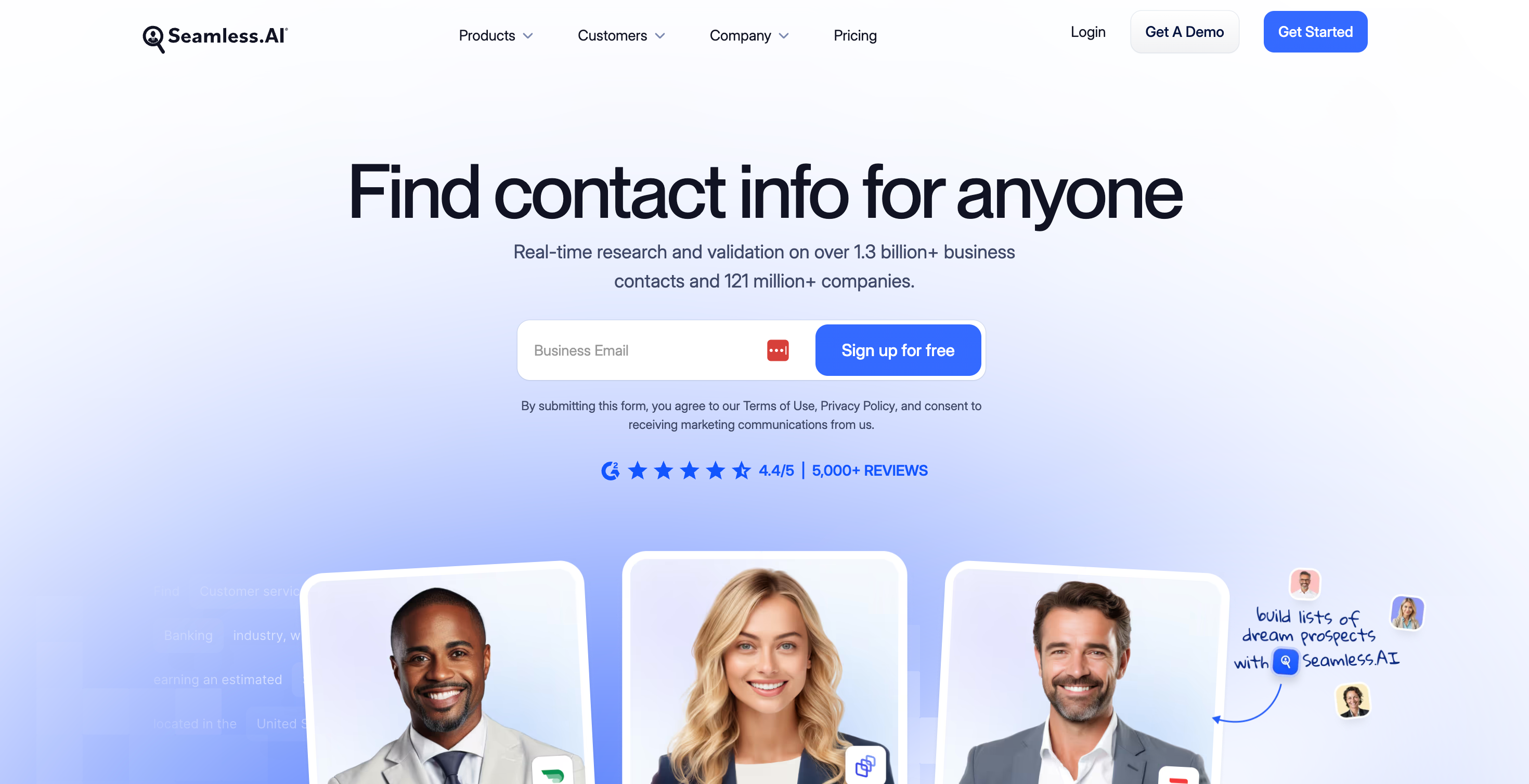
Uses real-time AI to crawl the web and find emails and direct dials. Strong enrichment capabilities, but usability varies depending on workflows.
6sense

Big on intent data and predictive analytics. Built for ABM motions and enterprise marketing alignment. More of a full platform than a pure contact tool.
HubSpot Sales Hub

Combines CRM, marketing automation, and prospecting tools. Good fit for growth teams already in HubSpot’s ecosystem and looking for integrated sales execution.
Clearbit
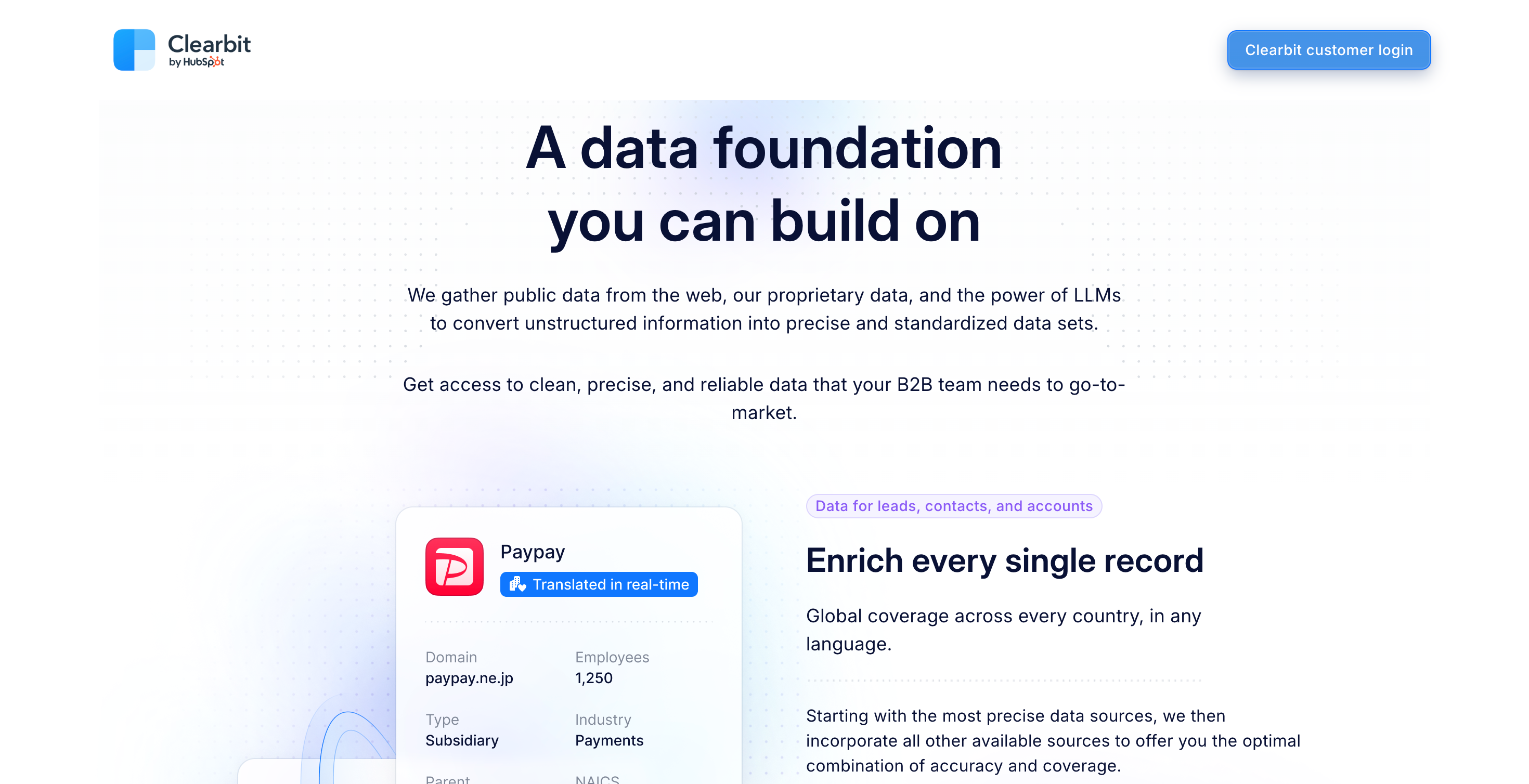
Focused on data enrichment, domain intelligence, and triggered outreach. Great for marketers building real-time website personalization and sales targeting.
Hunter.io
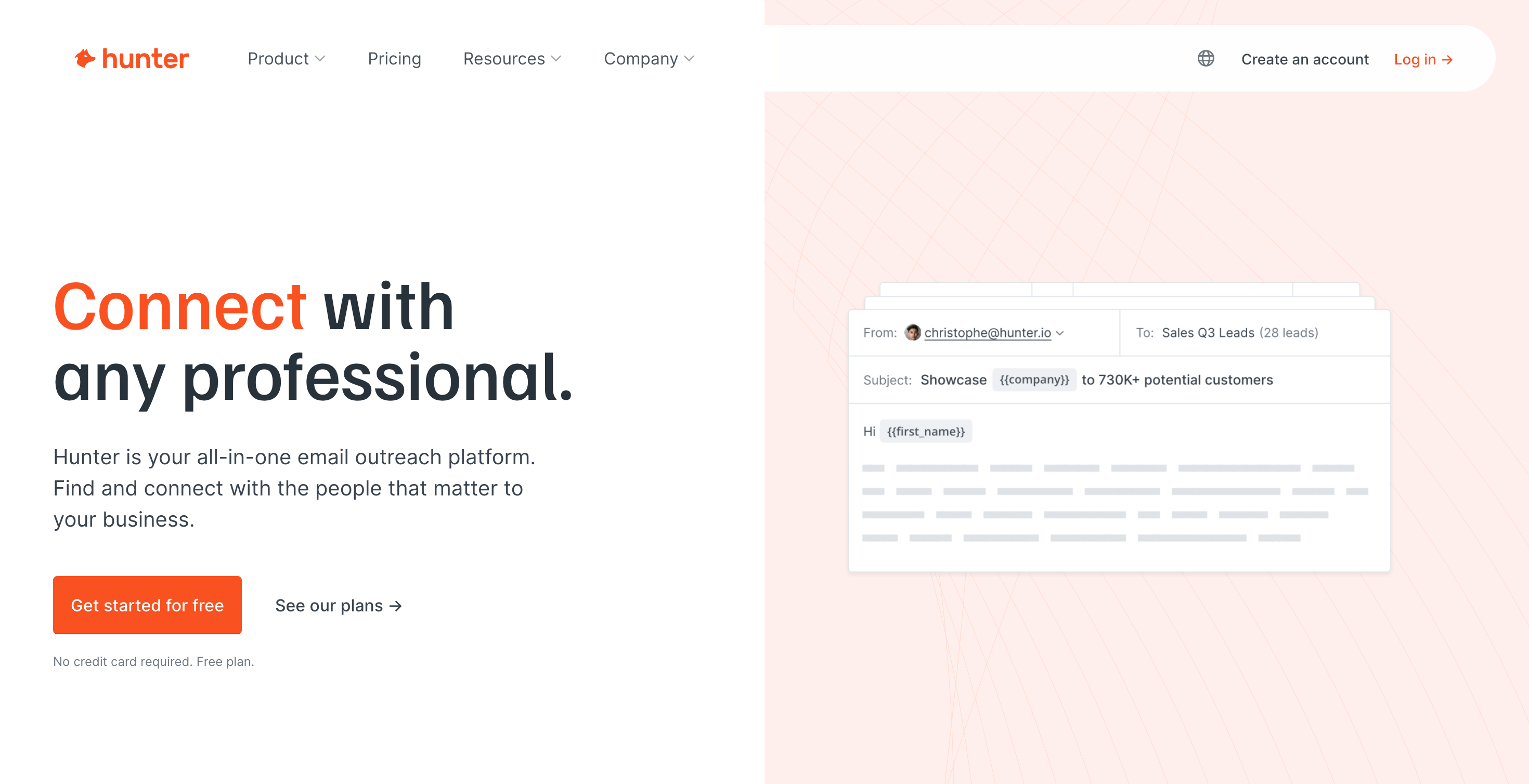
Simple tool for finding and verifying emails based on domain. Lightweight, browser-friendly, and useful for manual list building.
Lusha
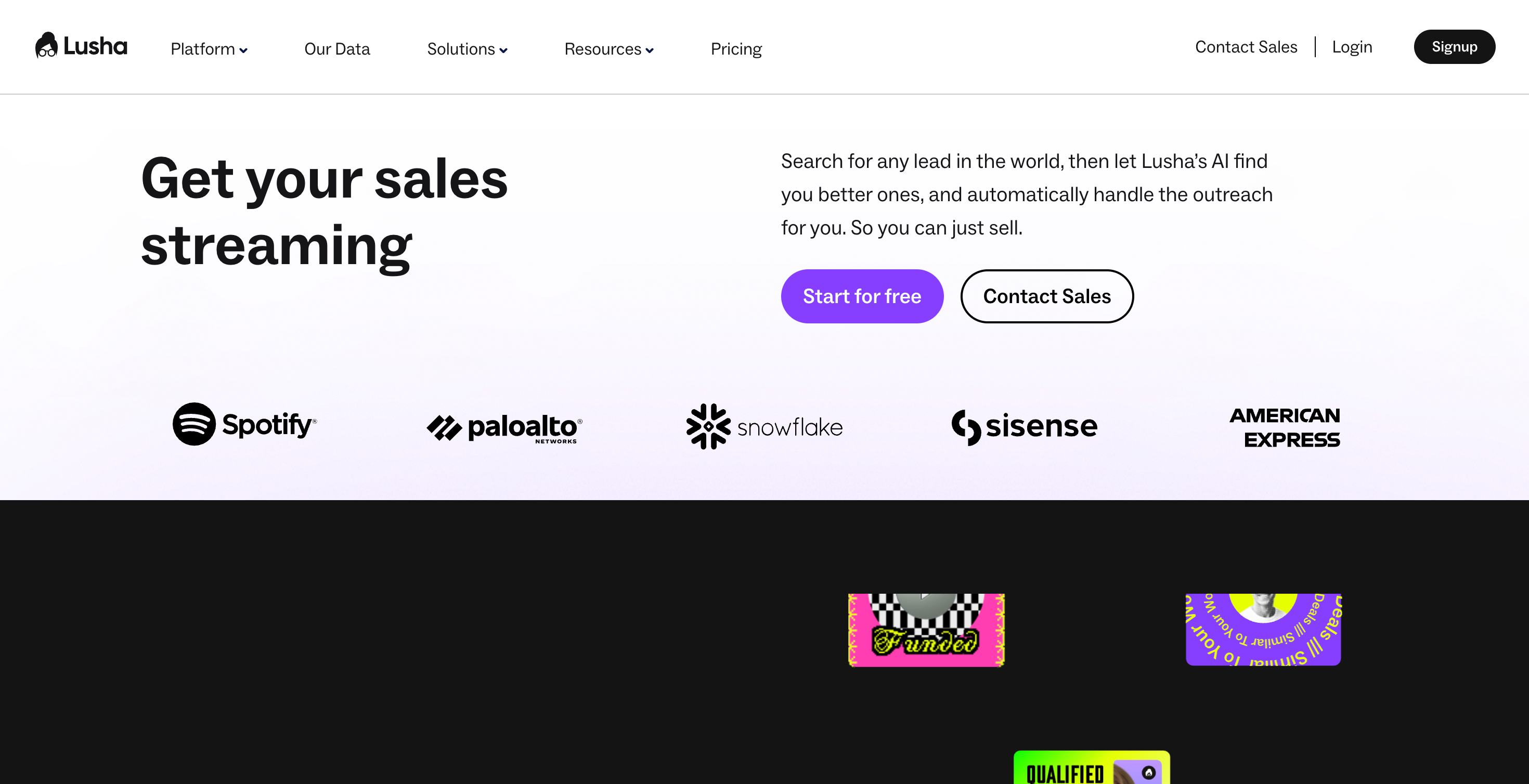
Easy-to-use enrichment extension paired with its own B2B database. Good accuracy for contact info. Works well inside platforms like LinkedIn.
Uplead
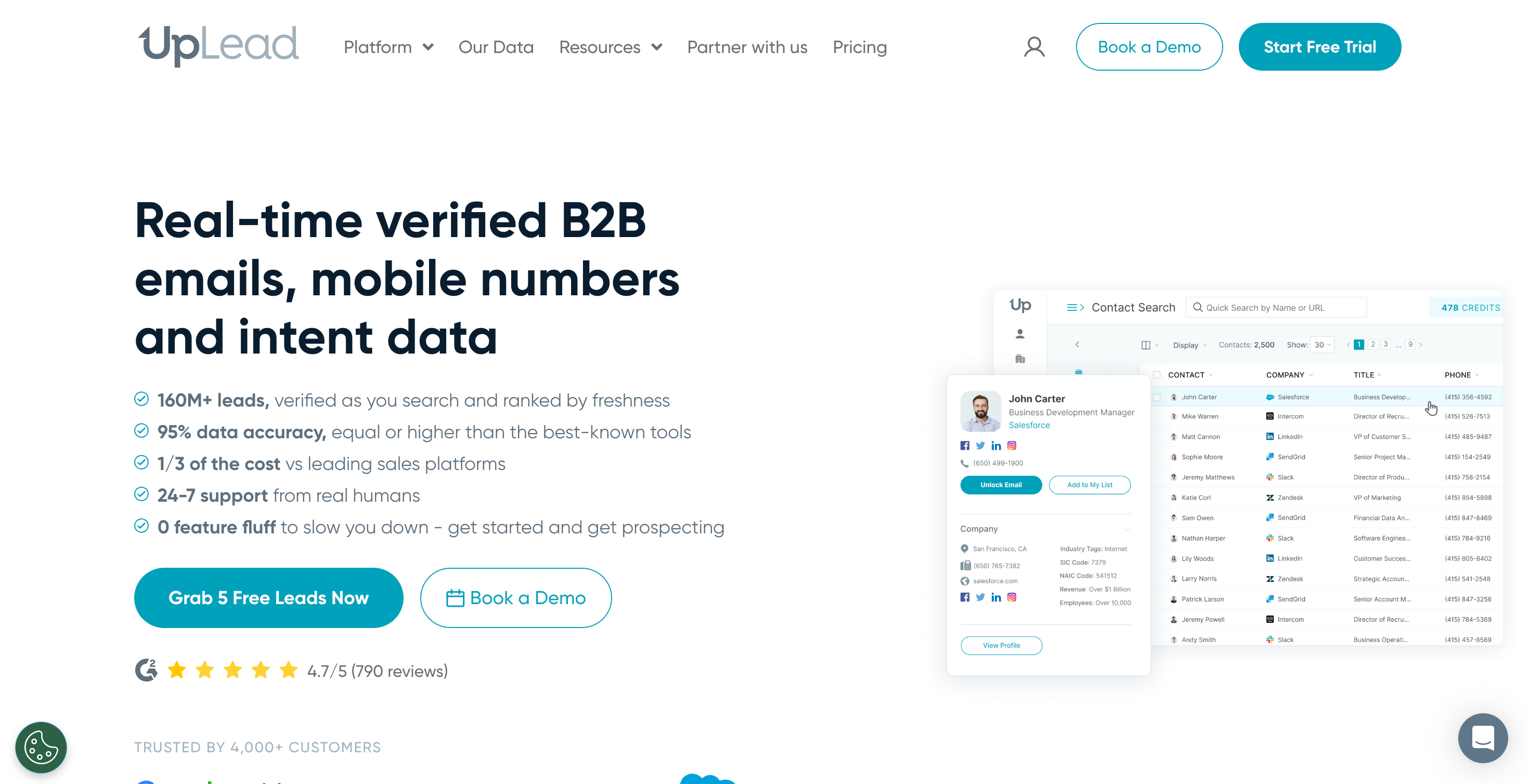
Mid-market focused with strong filtering and email verification baked in. Pay-per-credit model makes it startup-friendly.
Kaspr
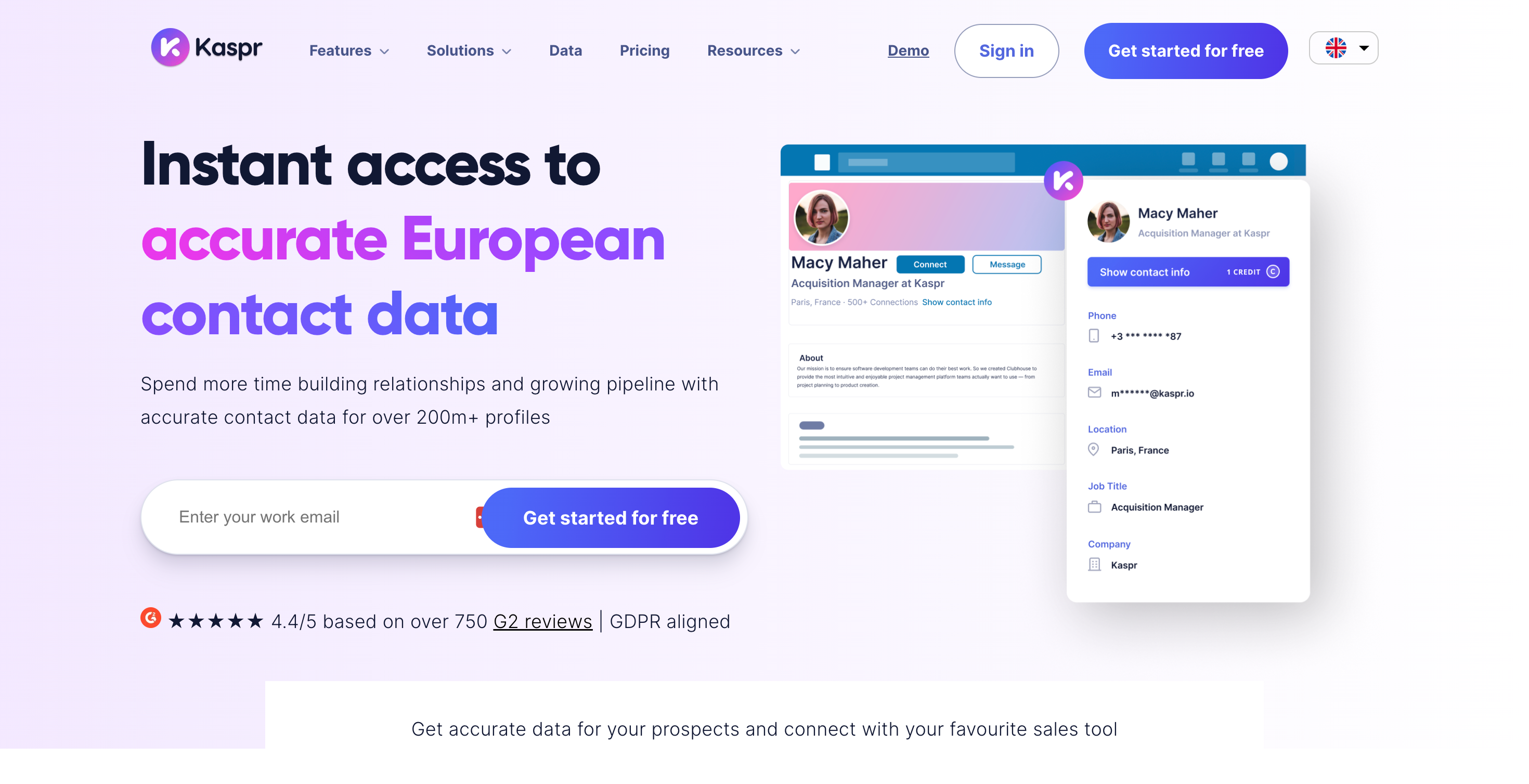
Automated enrichment tool focused on European data. Integrates with LinkedIn via Chrome extension. Good for quick scrapes and real-time updates.
D&B Hoovers
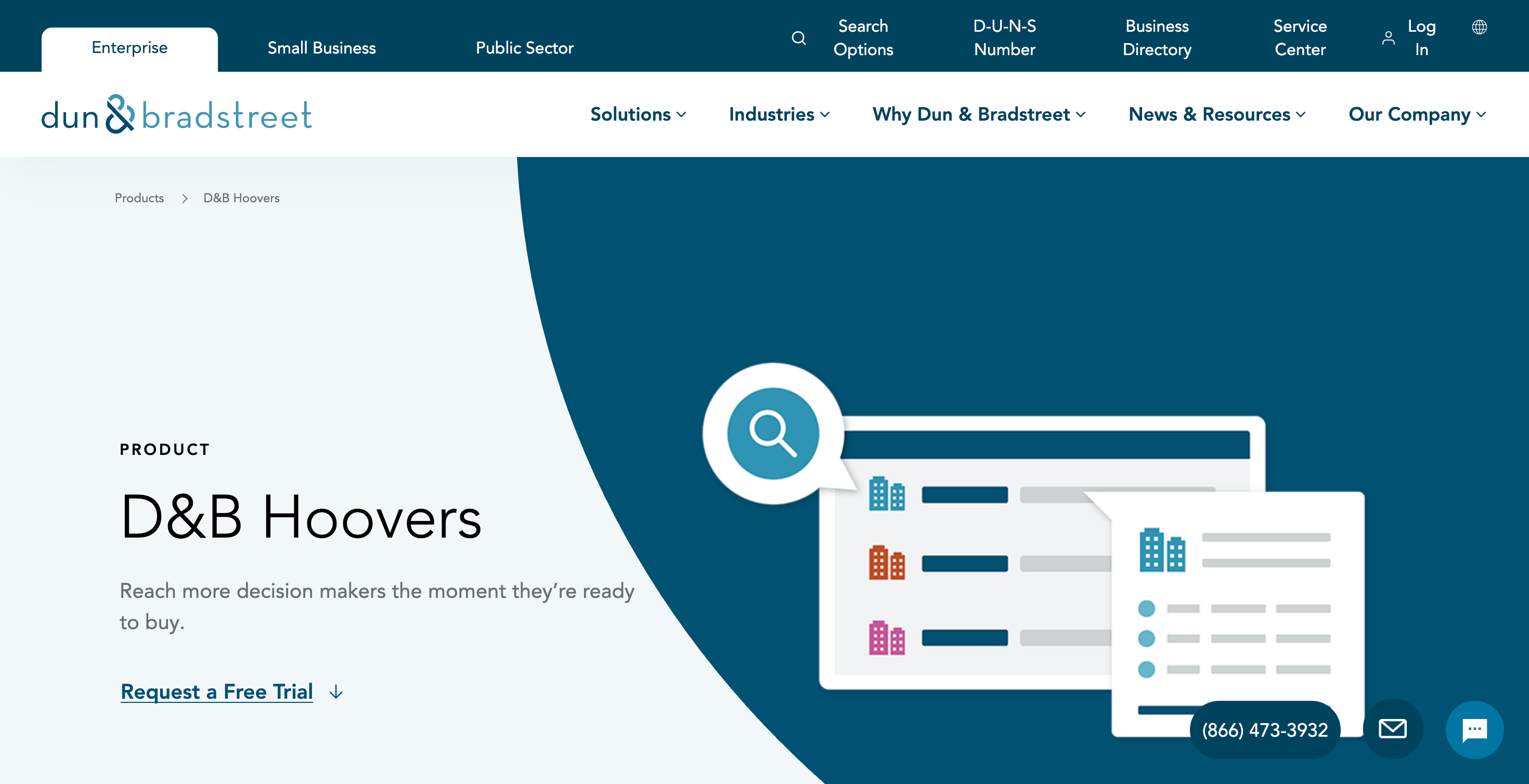
Large-scale corporate data provider with deep company-level data. Often used by financial and enterprise sales teams needing detailed firmographics.
Bombora
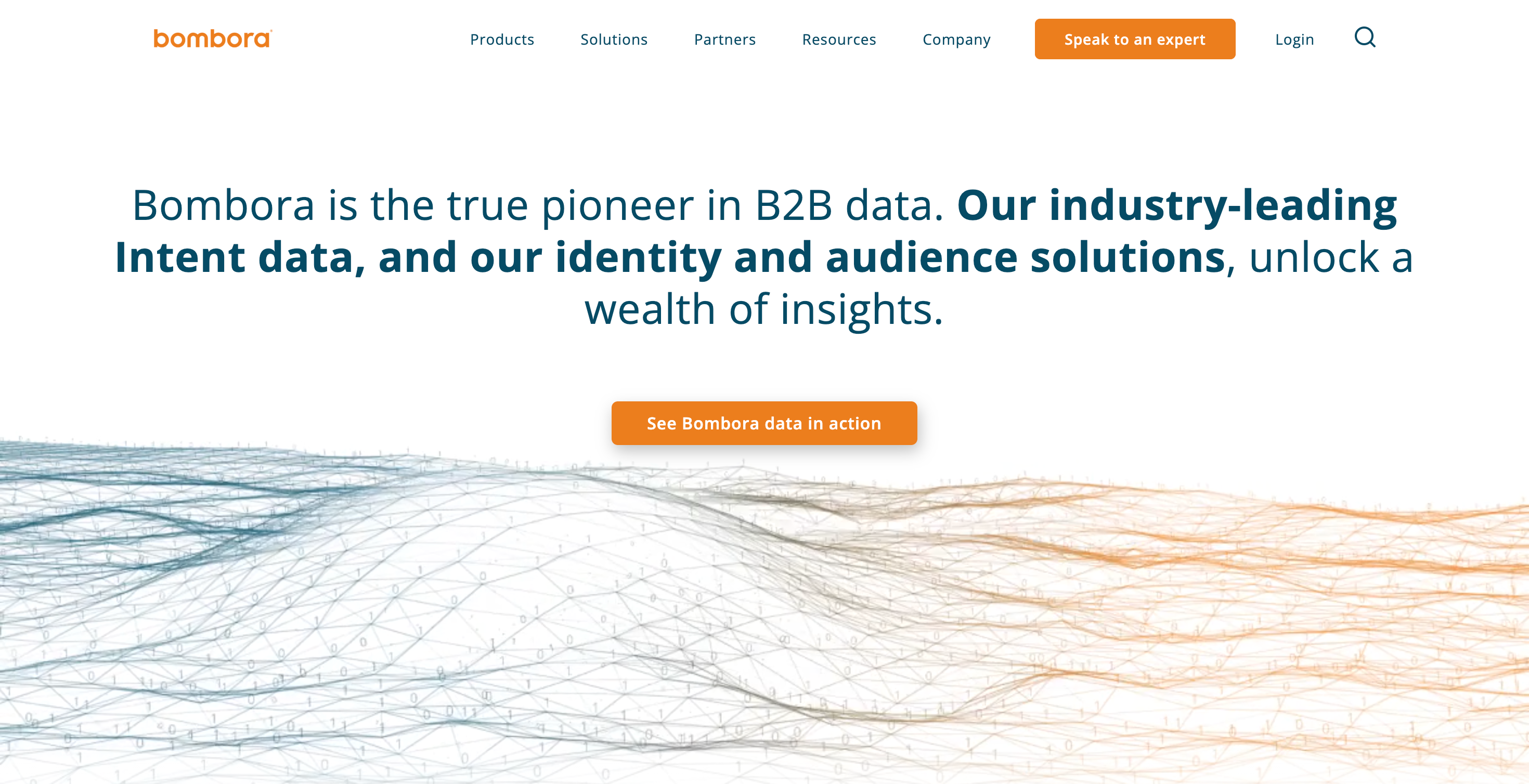
One of the top third-party intent data providers. Tracks content consumption trends to identify companies in active buying journeys. Essential for intent-based outbound.## How to Choose the Right Sales Intelligence Platform
Match features to your sales goals
Start with the outcome. Are you optimizing for pipeline velocity? Higher connect rates? More marketing-qualified leads flowing to AEs? Your goals dictate what tool you actually need.
If you're running high-volume outbound campaigns, you'll want fast enrichment, signal monitoring, and deep automation. If you're account-based, prioritize data precision, firmographic filters, and integration with ABM platforms.
Too many teams build around feature checklists. But a bells-and-whistles tool that doesn’t tie into your motion won’t move the numbers.
Evaluate data quality and breadth
Data accuracy and freshness
Stale contact data tanks deliverability. Wrong job titles waste time. A good platform updates records constantly, ideally with real-time inputs, web scrapes, or verified APIs. Accuracy isn’t negotiable when your cold open rate depends on getting emails right the first time.
Industry and geographic coverage
Some tools dominate in the US. Others shine in EMEA or APAC. Some have deep SaaS coverage, while others lean toward manufacturing, healthcare, or niche verticals.
Make sure your platform has real depth where you operate, down to titles, sub-industries, and regions. Volume means nothing if it's the wrong people.
Integration with existing tools (CRM, marketing automation)
If your sales intelligence tool doesn’t plug into Salesforce, HubSpot, or your marketing automation stack, it’s friction by default. Look for native integrations or open APIs that sync data and trigger workflows, whether that’s launching a Clay sequence or updating a lead score.
The tighter the integration, the fewer manual steps for your team. This is especially critical if you're running a complex GTM system where sales, marketing, and ops are sharing workflows.
User experience and UI
Your operators will live inside this tool. If it’s clunky? They won’t use it.
Good UX doesn’t just look clean, it reduces clicks, makes data easy to action, and doesn’t require a 40-page training manual. Test-drive the platform like a rep would. Can you surface a VP of Revenue Ops in your ICP with active buying signals in less than 30 seconds?
Scalability for growing teams
Your data demands won’t stay static. And if your platform charges per seat or can’t handle increased territories, you're going to hit a wall fast.
Look at how easily the tool scales across use cases (SDR, marketing, CS), volumes (1K leads vs 500K), and geos. Can it support multiple teams running different plays simultaneously?
Pricing models and total cost of ownership
Some tools charge you per contact. Others by seat. Some gate key features unless you’re enterprise. Always map pricing back to outcomes, cost per lead generated, cost per meeting booked, etc.
Don’t just look at the sticker price. Include onboarding, integrations, enrichment credits, and ops time. The “cheap” platform might actually cost more in workflow drag.
Support, training, and onboarding
Even the best engine sputters without a skilled operator. Check what onboarding looks like. Do they train your team deeply? Is support responsive? Do they help your GTM operator embed the tool into motion?
Some providers hand you the keys and disappear. Others invest in your team's success with real implementation help.
Customization and workflow alignment
Your GTM isn't plug-and-play. Your intelligence platform shouldn’t be either.
Look for tools that support custom fields, flexible routing logic, tagging, API connections, and modular workflows. If your outreach flows from a Signal → Clay sequence → Salesforce → Slack alert, the platform needs to accommodate that chain without breaking.
Technical operators often stretch tools to their edge. If it’s too rigid, it’ll snap.
Best Practices for Implementing Sales Intelligence Automation
Establish clear goals and KPIs
Automation without intent is chaos. Before implementation, define what “working” looks like. Is it more replies? Shorter sales cycles? Faster lead handoff? Build your intelligence system around those north stars.
Then set KPIs to measure it: lead response time, sequence engagement rates, SQL conversion, etc. Let data improvement justify the automation, not automation for its own sake.
Involve sales teams early in the process
The best systems win buy-in before rollout. Pull in SDRs and AEs from day one. Let them stress-test workflows, flag data gaps, and pressure-test a few live sequences.
This shortens adoption curves and surfaces blind spots early. Reps also serve as reality checks, so you’re not building a system operators won’t actually use.
Invest in team training and onboarding
You’ve spent the time building an automated motion. Don’t lose momentum because reps don’t know what to do with it.
Train sales on interpreting signals, triggering the right plays, and enriching contacts on the fly. Build internal documentation. Run deep onboarding sessions. A GTM system only scales if everyone knows how to operate within it.
Align automated data flows with CRM systems
Disconnected data = lost revenue. Every automated workflow should pipe intel directly into the CRM, accurate, enriched, and well-tagged. This keeps handoffs clean between outbound, sales, and CS.
Create unified schemas and workflows that let automation update lead status, trigger stage changes, log activity, and fuel dashboards. No data should live in isolation. That’s how pipelines leak.
Test and optimize outreach templates
Don’t launch sequences blindly. Use data to inform which messaging hits. Run A/B tests on subject lines that reference buyer intent or technographic triggers. Compare reply rates by channel (email vs LinkedIn vs phone) informed by signals from your intelligence platform.
Good templates are never written once. They’re pressure-tested, iterated, and rebuilt constantly based on what the data actually says.
Monitor performance with analytics dashboards
Your workflows are only as good as your visibility. Set up dashboards that track key events: new high-intent accounts, conversion rates by source, enrichment usage, and drop-off points.
Dashboards help spot where systems break, like an intent signal that never triggers action, or when performance drops because template fatigue set in.
Iterate based on feedback and insights
Once live, the system needs feedback loops. What blockers are reps hitting? Which leads are actually converting? What patterns are working in high-performing sequences?
Treat your sales intelligence automation like a product. Review weekly, deploy updates, and keep tuning. Success isn’t a one-time setup, it’s ongoing iteration driven by the front lines.
Sales Intelligence in the Modern Sales Strategy
The shift to account-based selling (ABS)
Sales intelligence isn’t just contact-level anymore. ABS requires company-wide context, funding rounds, hiring, tech stack shifts, site behavior, across multiple roles and levels. That data fuels orchestrated multi-threading, not just cold outreach.
Signal density now dictates targeting. When enough triggers fire, the entire account becomes worth engaging. Sales intelligence makes that judgment call automatic.
Role in revenue operations (RevOps)
In RevOps, sales intelligence isn't a line item, it’s core infrastructure. It feeds lead scoring. Shapes routing logic. Powers pipeline forecasting. GTM ops live and die by data quality, velocity, and connectivity.
Modern RevOps teams don't manually pull lists. They architect automated systems that serve ready-to-act signals to sales and marketing in real time. Sales intelligence is the upstream fuel.
How AI is transforming buyer engagement
AI sees what humans miss, timing, intent shifts, signal combinations. It doesn’t just tell you who to target, it decides when and how. Is the intent strong enough yet for outreach? Which persona engages best on LinkedIn? AI deciphers it in milliseconds.
It also writes. AI-powered recommendations and outreach tools turn signal-rich data into full email drafts, optimized for response. That’s no longer science fiction, it’s standard practice.
Sales enablement through automation
Enablement isn’t just content libraries. It’s surfacing the right account at the right time with the right message and giving reps everything they need to act fast.
Automated sales intelligence does just that, enriching profiles, triggering workflows, and offering up templates based on context. Reps no longer waste cycles researching. The system does the heavy lifting, so humans can close.
Future Trends in Sales Intelligence Automation
Rise of generative AI in sales personalization
One-touch personalization is already live. Tools now combine buyer signals and CRM history to write on-brand, hyper-relevant outreach in seconds, with tone, pain points, objections, and CTAs baked in.
The next leap? Multi-channel personalization across voice, SMS, and social. Generative AI will stitch together journeys, custom, context-rich, and sequence-aware.
Predictive AI for deal forecasting and qualifying
Forget win/loss after the fact. Predictive AI is starting to flag deal health the moment an opportunity opens, using behavior trends, engagement data, and external signals.
Qualifying won’t just be BANT checklists, it’ll be dynamic. Teams will know if a deal’s slipping two weeks before the rep does. That visibility changes how you coach, forecast, and act.
Full-funnel automation from SDR outreach to closing
Automated sales intelligence is expanding beyond the top of funnel. Signal-based workflows will soon span SDR handoff, mid-funnel staging, AE engagement, and even CS enablement.
Imagine an AE getting notified that a champion just ran a competitor comparison on G2, and their task queue auto-adjusting to prioritize that account. That’s full-funnel automation in action.
Voice and conversational intelligence
Call recordings are gold mines. With advances in NLP, platforms are mining them for objections, themes, competitor mentions, and sentiment shifts.
Soon, sales intelligence won’t just be digital signals, it’ll include high-resolution context from every conversation. That feeds back into lead scoring, messaging strategies, and even product marketing.
Increased privacy, compliance, and ethical data use
B2B data is under the microscope. As regulations tighten, platforms have to prove compliance, GDPR, CCPA, local laws, and handle data sourcing ethically.
Expect stricter verification, visible consent tracking, and non-invasive enrichment techniques. Intelligence tools will no longer get away with “we got it from the internet.”
Real-World Use Cases and Case Studies
Outbound prospecting and campaign performance
A mid-market SaaS team layered automated intelligence on top of their outbound, signals like job changes, tech stack shifts, and surging topics.
Using those triggers, they ran Clay campaigns customized by signal type. The result: A 4x reply rate increase and meetings booked with 61 percent of high-score accounts. Manual prospecting couldn't even come close.
Integration with ABM platforms for targeting
One enterprise revops team integrated their intelligence platform with their ABM engine to dynamically update tiered segments. When a buying signal fired, such as a product manager downloading a whitepaper, accounts automatically upgraded tiers and got pulled into multi-touch campaigns.
It made ABM real-time, not static. That shift boosted pipeline creation velocity across tier 1 accounts by 40 percent.
Real-time alerts for buyer intent & churn risk
A fintech company synced their buyer intent engine with CRM and Slack. When intent surged or negative product behavior occurred, internal alerts triggered instantly to AEs and AMs.
That speed led to faster follow-ups, but also churn mitigation. In one case, a VP of Product who didn’t respond to surveys turned out to be evaluating competitors. Proactive outreach saved the account.
Enabling reps with automated sales playbooks
Rather than force reps to read playbooks, one go-to-market team embedded plays directly into their tech stack.
When a high-intent lead hit the CRM, the system attached the right messaging sequence, pain point references, and call tactics, automatically. Reps didn’t need to guess what to do. Playbooks became workflows. Execution got standardized. Close rates improved.
FAQs
CRMs are databases. Sales intelligence is the engine that feeds and powers them.
Your CRM stores data, contacts, deals, stages, notes, but it doesn’t enrich it, prioritize it, or act on it. That’s where sales intelligence comes in. It adds real-time context: new job titles, buying signals, account-level triggers. It tells you who to talk to, when, and why.
Without sales intelligence, a CRM is just a spreadsheet in a prettier wrapper. With it, your CRM becomes actionable, part of a live GTM system, not just record-keeping software.
Predictive analytics models what’s likely to happen. Automated sales intelligence acts when it happens.
Think of predictive analytics as a weather forecast, it predicts, but doesn’t send you a jacket. Automated sales intelligence is your assistant who hands you the umbrella when it’s about to rain and sets your meeting with an umbrella manufacturer if you're in that market.
It uses prediction, but pairs it with signals, workflows, and automation to actually drive action. Prediction alone doesn’t close deals. Intelligence + automation does.
Mostly, yes, because B2B sales involve longer cycles, multiple stakeholders, and high-value deals where data matters.
B2C tends to move faster, with simpler funnels that don’t need this level of enrichment or signal-matching. B2B GTM motions, especially outbound and ABM, rely heavily on detailed account-level insights, technographic data, and job-role targeting. That’s the domain of sales intelligence.
But within B2B? Every team, sales, marketing, RevOps, CS, can benefit, not just sellers.
Absolutely. And in many cases, it’s a force multiplier for lean teams.
When you don’t have a big SDR squad or dedicated research staff, having an automated system that feeds you fresh, high-intent leads and personalized messaging suggestions is a game-changer. It lets small teams punch above their weight in outbound without burning resources.
The key is agility. Small teams move fast. With tools like Clay running point, they can skip spreadsheets entirely and drop leads straight into smart workflows.
Three primary mechanisms: API ingestion, web scraping, and third-party aggregators.
They pull from CRMs, LinkedIn, job boards, SEC filings, review platforms, and technographic vendors. Some crawl the web in real time. Others license data from established sources. Then AI checks, deduplicates, or cross-verifies the inputs, sometimes even using email validation and signal triangulation.
Quality varies, but the best platforms flag confidence levels or verification timestamps, so you know what to trust.
More accurate than humans guessing. But not perfect.
Lead scoring used to mean assigning random numbers to firmographics. Now? It’s driven by dozens of attributes, job changes, ad clicks, unread replies, tech adoption, finish rates on webinars, and it constantly optimizes based on what actually converts.
The accuracy depends on training data and feedback loops. When coupled with your CRM outcomes and GTM triggers, it becomes sharp. When it lives in isolation, it can misfire.
Best bet: use it as a filter, not gospel. Let AI narrow the field. Then let humans close.
Look for integrations that reduce manual handling and trigger automatic workflows.
- CRM (Salesforce, HubSpot) for data sync and scoring
- Sales engagement (Apollo, Outreach, Salesloft) for sequencing
- Intelligence signals (Bombora, LinkedIn) for trigger-based actions
- Slack or email for real-time alerts
- Workflow tools (Zapier, Make, webhooks) if you’re running custom GTM systems
The holy grail is motion-based: When X happens, trigger Y, enrich in Z. Any gaps in that sequence add friction. Avoid them.
It ranges from a few hundred bucks a month to six-figure contracts, depending on scale and features.
Entry-level tools like Apollo or Hunter start at under $100/mo per user. Mid-market platforms with intent data or automation (e.g. Clearbit, Cognism) often land between $3K–$20K/year. Enterprise tools like ZoomInfo, 6sense, or D&B Hoovers can run $50K+ annually.
Pricing models vary: per seat, per contact, or usage-based (number of enrichments, signals, syncs, etc.). Always factor in hidden costs like onboarding, API usage, and credits for enrichment, those can add up.
Yes, but only when you feed it usage and behavior data post-sale.
Many tools now integrate with product analytics, CS platforms, or NPS surveys, flagging churn risk based on reduced logins, feature drop-offs, or competitor signal spikes. Done right, those early warnings let AMs or CSMs intervene before it’s too late.
Retention isn't just about onboarding. It's about detecting red flags automatically. Sales intelligence closes the loop, from acquisition triggers to renewal alerts.
The reputable ones are. But definitions vary.
Some tools gather contact info with public sourcing and transparency baked in. Others rely on scraped data or overseas partners where compliance is less strict. GDPR and CCPA compliance means upfront: clear sourcing, opt-out mechanisms, data processing agreements, and region-specific rules.
B2B data vendors must balance reach with ethics. If you're unsure, ask:
- Where is this data sourced?
- How is consent handled?
- Can contacts request removal?
If your company operates in or targets users in the EU, UK, or California, double-check. Non-compliance has real risks. Get your legal, ops, or compliance team looped in early.
RELATED ARTICLES
Check out more articles on our blog!
RELATED ARTICLES
Lorem ipsum dolor sit amet, consectetuer adipiscing elit, sed diam nonummy nibh euismod tincidunt ut laoreet dolore magna aliquam erat volutpat.
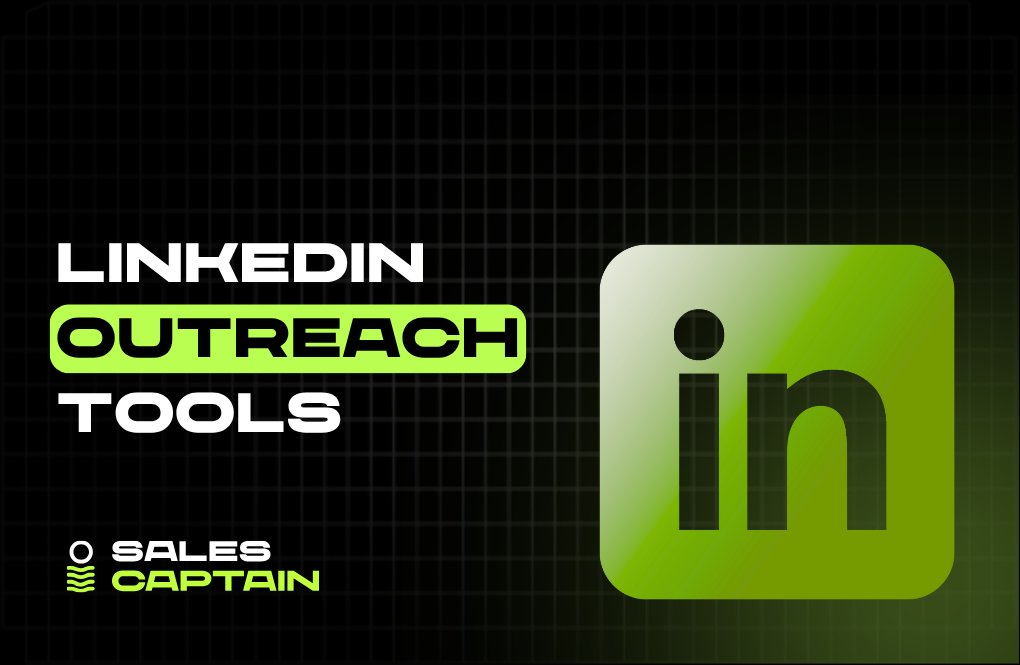

.png)

.jpg)


